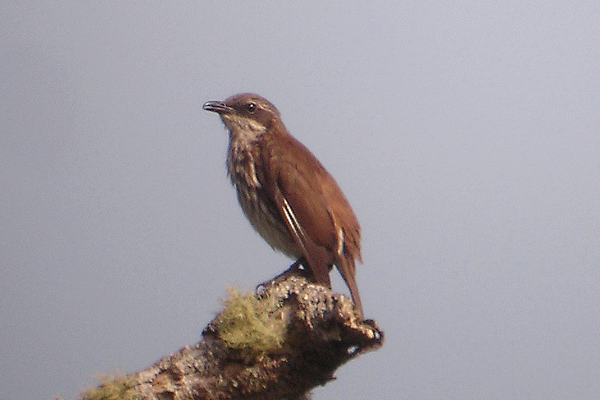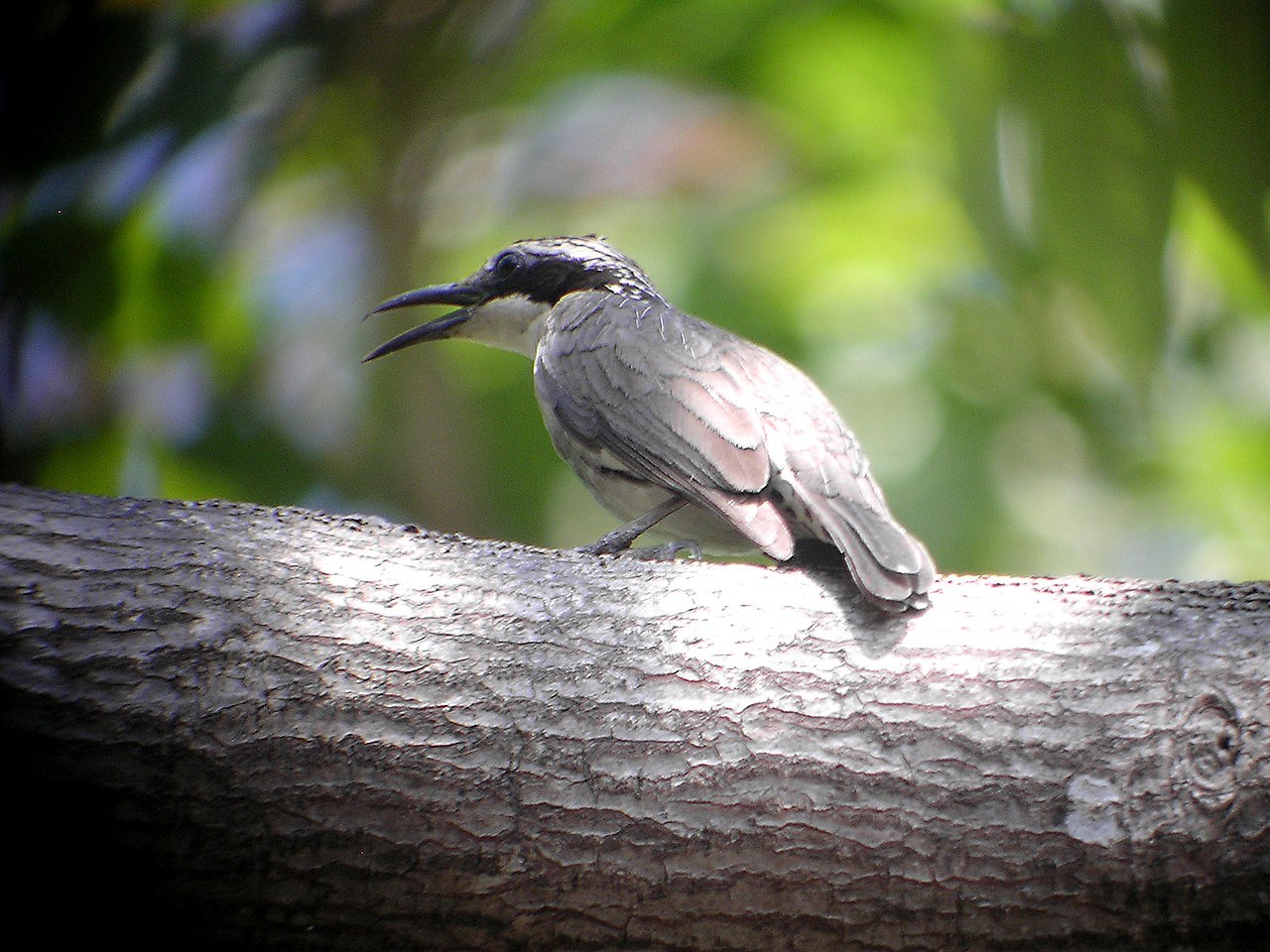Rhabdornis

Stripe-Headed Rhabdornis, by Mark A. Harper, CC BY-SA 2.0
Etymology: Stripe Bird
First Described By: Reichenbach, 1853
Classification: Dinosauromorpha, Dinosauriformes, Dracohors, Dinosauria, Saurischia, Eusaurischia, Theropoda, Neotheropoda, Averostra, Tetanurae, Orionides, Avetheropoda, Coelurosauria, Tyrannoraptora, Maniraptoromorpha, Maniraptoriformes, Maniraptora, Pennaraptora, Paraves, Eumaniraptora, Averaptora, Avialae, Euavialae, Avebrevicauda, Pygostaylia, Ornithothoraces, Euornithes, Ornithuromorpha, Ornithurae, Neornithes, Neognathae, Neoaves, Inopinaves, Telluraves, Australaves, Eufalconimorphae, Psittacopasserae, Passeriformes, Eupasseres, Passeri, Euoscines, Passerides, Core Passerides, Muscicapida, Muscicapoidea, Sturnidae
Referred Species: R. grandis (Grand Rhabdornis), R. inornatus (Stripe-Breasted Rhabdornis), R. mystacalis (Stripe-Headed Rhabdornis), R. rabori (Visayan Rhabdornis)
Status: Extant, Vulnerable - Least Concern
Time and Place: Within the last 10,000 years; in the Holocene epoch of the Quaternary period


Found entirely within the Philippines

Physical Description: Rhabdornis is a genus of small, distinctive songbirds that range between 15 and 19 centimeters in length from head to tail, making them about the length of a standard yellow pencil. They are all brownish in color, with slightly lighter colored feathers on the tops of their heads, and they have white belly feathers with brown stripes extending horizontally along the body. They have short tail feathers and long, thin bills, which end in a sharp curve. In general, the males and females are fairly similar in appearance, with the females only a little lighter in color. They are somewhat elongate in terms of overall body shape, rather than round; though they are still in general somewhat squat.
Diet: These birds eat a variety of small food, including insects, fruits, nectar, and seeds; are primarily opportunistic in terms of foraging for a variety of food material.

Stripe-Breasted Rhabdornis by Mark A. Harper, CC BY-SA 2.0
Behavior: These birds tend to forage together in small groups; depending on the species, the groups can range between 6 to 20 individuals, with some even forming mixed-species flocks during foraging if food is abundant. For example, when insects emerge from their cocoons, hundreds of birds can be found congregating together, with a variety of birds present. Rhabdornis utilizes its long beak to help get at food sources within tree cavities and dirt. They also use their brush like tongues to get food out of the bark, including nectar. Sometimes they are even able to catch insects on the wing. They form nests out of sticks and bark strips within tree holes, usually between 10 and 15 meters off of the ground; both adults aid in building the nest. Mating occurs from March through April, though at least one species waits to mate until May. None of these species migrate and, as small songbirds, this is a fairly skittish group of birds. They make high pitched calls that sound like “zeet” or “tzit”, which is hilarious to me personally because “tzitzit” are fringes in Hebrew, a structure needed on the corners of certain garments under Jewish law. That has nothing to do with the bird, I just found the fact that their calls are apparently “tzitzit” amazing for that reason.
Ecosystem: These birds entirely live in tropical forests, though at what elevation and where within the forest canopy depends on the species in question.
Other: These birds are rather difficult to place in terms of classification; debate rages over whether they count as their own family, or instead as members of the Starling group.

Stripe-Headed Rhabdornis by Mark A. Harper, CC BY-SA 2.0
Species Differences:
The different species of Rhabdornis differ mainly on range, subtle changes in coloration, and habitat. The Grand Rhabdornis sports a distinctive grey head; it lives primarily on the island of Luzon, and lives in middle to high elevation hardwood forests. The Stripe-Breasted Rhabdornis lives mainly in Mindanao as well as Visayas, and has a taupe colored head - though it also lives in mountain and middle elevation forests. Still, it prefers the canopy of these forests, where the Grand Rhabdornis is found throughout the forest levels. The Stripe-Headed Rhabdornis has a brown head with stripes running across it; it lives throughout the Philippine islands and is found usually at sea level, in new forest areas and along the forest edge. Finally, the Visayan Rhabdornis lives in middle to high elevation forests, mostly at the forest edge and new growth in the canopy level; it has a snowy colored head and is found mainly in the Visayas islands. While the first three species are all not threatened with extinction, the Visayan Rhabdornis is vulnerable to extinction due to its restricted range and small subpopulations.
~ By Meig Dickson
Sources under the cut
del Hoyo, J., Collar, N. & Christie, D.A. (2018). Visayan Rhabdornis (Rhabdornis rabori). In: del Hoyo, J., Elliott, A., Sargatal, J., Christie, D.A. & de Juana, E. (eds.). Handbook of the Birds of the World Alive. Lynx Edicions, Barcelona.
del Hoyo, J., Elliott, A., Sargatal, J., Christie, D.A. & de Juana, E. (eds.) 2018. Handbook of the Birds of the World Alive. Lynx Edicions, Barcelona.
Kennedy, R. & Miranda, H. 2018. Grand Rhabdornis (Rhabdornis grandis). In: del Hoyo, J., Elliott, A., Sargatal, J., Christie, D.A. & de Juana, E. (eds.). Handbook of the Birds of the World Alive. Lynx Edicions, Barcelona.
Kennedy, R., Miranda, H. & Christie, D.A. 2018. Stripe-breasted Rhabdornis (Rhabdornis inornatus). In: del Hoyo, J., Elliott, A., Sargatal, J., Christie, D.A. & de Juana, E. (eds.). Handbook of the Birds of the World Alive. Lynx Edicions, Barcelona.
Kennedy, R. & Miranda, H. 2018. Stripe-headed Rhabdornis (Rhabdornis mystacalis). In: del Hoyo, J., Elliott, A., Sargatal, J., Christie, D.A. & de Juana, E. (eds.). Handbook of the Birds of the World Alive. Lynx Edicions, Barcelona.
Jobling, J. A. 2010. The Helm Dictionary of Scientific Bird Names. Christopher Helm Publishing, A&C Black Publishers Ltd, London.




















